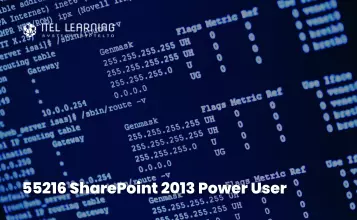Overview
This course covers the following core features in Dynamics 365: core common features, core configuration, data migration, and preparing to go live.
Prerequisites
Before attending this course, students must have:
- General knowledge of Microsoft Windows
- The ability to use Dynamics 365 for Finance and Operations for basic processing and navigation
- Experience being a functional or technical consultant who has used Dynamics Finance Apps to gather and analyze business requirements
- General knowledge of basic mobile device features and navigation
- The student should be able to take a synchronous, virtual course and communicate feedback in a positive, constructive manner
Course Duration
2 Days
Course Outline
- Digital transformation is business transformation
- Microsoft business applications
- Artificial intelligence
- Mixed Reality
- Navigation elements
- See how workspaces drive productivity
- Use filtering techniques
- Search in finance and operations apps
- Compare views
- How to use View and Edit modes
- Benefits of Dynamics 365 Finance
- Overview
- General ledger
- Cash and bank management
- Tax
- Accounts payable
- Accounts receivable
- Credit and collections
- Budgeting
- Fixed assets
- Cost accounting
- Electronic invoicing
- Lab – Explore Dynamics 365 Finance
- Core concepts in production control
- Understand unified manufacturing
- Manufacturing principles
- Overview of the production process and production life cycle
- Discrete manufacturing
- Process manufacturing
- Lean manufacturing
- Configure production control for unified manufacturing
- Capacity planning
- Integration between the General ledger and the Production control modules
- IoT intelligence and insights
- Lab – Explore production control
- Introduction
- Microsoft Learn site
- In-product help
- Customize help topics
- Protecting the privacy and personal data of your customers
- Understand the functionality and tools of Lifecycle Services
- Lifecycle Services security
- Reuse existing assets, copy, and share data
- Perform actions in the Asset library
- Work with the Task recorder
- Business process modeler (BPM)
- Issue search and support
- Get product updates from Lifecycle Services
- Exercise – use the Task recorder to create and edit a recording
- Exercise – create a business process modeler
- Exercise – create a support incident
- Use implementation methodologies for a successful implementation
- Cloud implementation – analysis
- Cloud implementation – design and develop
- Cloud implementation – test
- Cloud implementation – deploy and operate
- On-premises implementation – analysis
- On-premises implementation – design and develop
- On-premises implementation – test, deploy, and operate
- Gathering and analyzing the requirements
- Create functional design documents (FDD)
- Access Dynamics 365 Translation Service
- Types of requests
- Reuse translations (recycling)
- Custom-trained machine translation system
- Exercise – Create, review, and regenerate a user interface translation request
- Exercise – Create, review, and regenerate a documentation translation request
- Exercise – Create a translation memory file
- How the global address book works
- Plan for the global address book and other address books
- Lab – Configure address books
- Lab – Add a new record and check for duplicates
- Create a legal entity
- Create a number sequence
- Understand organizational hierarchies and operating units
- Plan your organizational hierarchy
- Decide whether to model internal organizations as legal entities or operating units
- Decide whether to model internal organizations as legal entities or operating units (cont.)
- Best practices for modelling organizations and hierarchies
- Apply purposes and policies
- Distributed order management (DOM) policy
- Configure calendars and date intervals
- Lab – Configure a new legal entity
- Lab – Create an operating unit
- Lab – Create an organization hierarchy
- Lab – Set up a number sequence
- Understand the security architecture
- Encryption in finance and operations apps
- Manage users and security
- Set up and apply segregation of duties
- Run security reports
- Stay compliant with user licensing requirements
- Security diagnostics for task recordings
- Extensible data security policies
- Exercise – Import a user and assign security role
- Lab – Work with security
- Overview of batch processing
- Batch processing and batch servers
- Batch processing of reports and setup of alerts
- Copy a batch job
- Batch job manager role
- Unlock a journal
- Lab – Work with batch jobs and set up alerts
- Workflow types for business processes
- Create and set up workflows
- Assign users to workflow elements
- Use the daily journal workflow
- Lab – Create a purchase requisition workflow
- Demonstration
- Overview of the Dynamics 365 Unified Operations mobile app
- Page design guidelines
- Action design guidelines
- Form design requirements
- Design considerations
- Understand use cases for mobile apps
- Get the Dynamics 365 Unified Operations mobile app
- Understand the differences between customization and personalization
- Apply user options
- Implicit personalization
- Administer personalization
- Saved views
- The personalization toolbar
- Personalize a workspace
- Personalize a dashboard
- Personalize inventory dimensions
- Create and maintain record templates
- Lab – Personalize user options
- Lab – Create and use a record template
- Microsoft Office integration
- Excel workbook designer
- Document management
- Configure email (SMTP/Exchange)
- Create an email template
- Power BI in finance and operations
- Set up network printing
- Integrate data from multiple sources into Microsoft Dataverse for Apps
- Lab – Work with Microsoft Office integration
- Feature management workspace
- Feature states
- Enable a feature
- Reschedule a feature
- Disable a feature
- Features that must be enabled
- Enable all features
- Check for updates
- Assign roles
- Features that use configuration keys
- Data entities
- Select a data integration (import/export) strategy
- Common migration scenarios and tools
- Bring your own database (BYOD)
- Test a data migration and validate output
- Data management concepts
- Use data entities for data management and integration
- Work with the Data management workspace
- Using Standard and Enhanced views for tiles
- Use templates in data management
- Export, import, and copy data into a legal entity
- Lab – Explore the Data management workspace
- Lab – Export data using the Data management workspace
- Database movement operations
- Create user acceptance test libraries
- Record test cases and save to BPM
- Synchronize and configure your test plan in Azure DevOps
- Run user acceptance tests
- Data task automation
- Exercise – Build test scripts to test business functionality
- Understand the go-live process
- Complete the Lifecycle Services methodology
- Perform user acceptance testing (UAT) for your solution
- FastTrack go-live assessment
- Understand different types of reports and inquiries
- Financial reporting
- Find inquiries and reports
- Generate and consume inquiries and reports
- Configure finance and operations apps for Microsoft Power Platform
- Lab – Work with reports
- Configure electronic reporting
- Use barcode data sources to generate bar code images
- Lab – Generate electronic documents for payments








